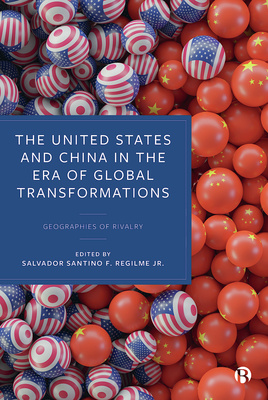China’s Challenge to United States Dominance

This blog post reflects on insights from the forthcoming book - 'The United States and China in the Era of Global Transformations'. It highlights the evolving nature of this bilateral relationship and emphasizes the need to consider the consequences for marginalized populations and global transformation.
The US-China rivalry revolves around three key global factors: First, the post-World War II global order is evolving, with the US losing its dominance as China emerged as a manufacturing powerhouse, extending its influence worldwide. Amid the pandemic and looming inflation crisis, both nations remain dominant yet in conflict. Second, the Western-led global order is grappling with an ideological crisis driven by unfair distribution of wealth that breeds resentment among the marginalized. Third, regional actors are increasingly active in mediating the projection of US and Chinese influence.
This last shift is evident as many countries, particularly in the Global South, are gaining significant influence and power themselves. In Africa, for instance, China’s investments have empowered nations to diversify their economies and enhance their global standing while also reinforcing the regimes therein. Similarly, Latin American countries have fostered economic and diplomatic ties with both superpowers, leveraging their resources and strategic locations to boost their independence and influence. This dynamic suggests that great power rivalry must be examined through the lens of its interactions with actors and structural processes that operate in particular regions.
 Powerful states often diverge from professed ideals. The US prioritizes militarism and capital accumulation over values such as human rights and democratic governance, while China emphasizes socio-economic rights but restricts civil liberties in the supposed support of economic growth and social cohesion. In both cases, however, capitalism became the governing logic of the economy, which has improved living standards for many but nevertheless has also fostered sustained inequality, polarization, and distrust in institutions in the long term.
Powerful states often diverge from professed ideals. The US prioritizes militarism and capital accumulation over values such as human rights and democratic governance, while China emphasizes socio-economic rights but restricts civil liberties in the supposed support of economic growth and social cohesion. In both cases, however, capitalism became the governing logic of the economy, which has improved living standards for many but nevertheless has also fostered sustained inequality, polarization, and distrust in institutions in the long term.
China has emerged as a significant state actor capable of challenging the dominance of the US and its Western allies in the post-Cold War global landscape. Of the resurgent powers including India, Russia, and Brazil, China has emerged as the sole state actor displaying the ambition and capacity to bolster its military prowess, economic influence, and social credibility, thereby potentially curtailing the US’ sway across the world. China has ascended to become the world’s largest manufacturing hub and foremost exporter of goods, concurrently reinforcing its worldwide military capabilities and presence in international governance organizations.
China’s rapid economic growth since the late 1970s, when it opened its economy to global trade, is striking. This era saw an average annual economic expansion of no less than 10%, lifting nearly a billion individuals out of dire poverty, an accomplishment often credited to Beijing’s supposedly effective technocratic governance strategy. Even amidst the COVID-19 pandemic in 2021, China achieved a noteworthy growth rate of 8.1%, surpassing the economic expansion of the US and its Western European allies, which was less than half as high.
Leveraging this remarkable economic success, the Chinese government committed to transforming its economic might into military strength. In 2022, the Chinese Ministry of Finance revealed a notable 7.1% increase in military expenditure, approximating around 230 billion USD, an increase that surpassed the 6% average of previous years, although still notably lower than US defense spending, which exceeded 778 billion USD by 2022. Nevertheless, China is banking on the potential of revolutionary technologies such as autonomous systems and quantum, cyber, and biological advancements, which could potentially challenge US dominance in the Indo-Pacific region.
In a forthcoming book, my colleagues and I focus on 21st-century major power rivalries and uphold spatialization as a critical tool for understanding socio-ideational and material processes in relation to geography. It positions the analysis of the US-China rivalry at the intersection of physical geography, social interactions, and global politics. This interdisciplinary approach deploys diverse methodologies and analytical perspectives from global regions, offering a comprehensive multi-scalar exploration of 21st-century power shifts. This aligns with calls for a more productive dialogue between Global IR approaches and area studies, facilitating a thorough examination of prevailing paradigms, and the emergence of new theoretical viewpoints rooted in empirical evidence from diverse world regions.
Unlike mainstream narratives suggesting an impending war between China and the US, our book emphasizes the nuanced and multifaceted nature of their bilateral relationship. We highlight that this complexity is shaped by various social and political factors in specific global regions. For instance, the US-China rivalry differs among Southeast Asia, the Middle East, and the Arctic regions due to varying causes and consequences across different world regions and territorial spaces.
In Southeast Asia, the US-China rivalry centers on the South China Sea (SCS) dispute. China’s assertive actions, such as land reclamation, have heightened tensions with smaller SCS claimants. In response, these states bolster their defense capabilities and welcome an increased US military presence. The SCS is now a heavily militarized hotspot, with four Southeast Asian nations claiming portions of it.
In the Middle East, rivalry stems from shifting superpower dynamics, whereby the region’s energy resources and geopolitical significance attract both the US and China. Indeed, the US has a historically enduring Middle East presence, while China’s economic interests raise concerns.
In the Arctic, China’s challenge of US-led dominance arises from Beijing’s strategic interest. Despite its geographic distance, China asserts itself as a near-Arctic state pursuing cooperation with Arctic nations. The Arctic offers economic and geopolitical advantages such as resource access and seabed exploration. This concerns Arctic states, including the US, which are traditionally vested in Arctic sovereignty and decision-making authority over the region.
Notably, the number of people experiencing extreme poverty will continue to increase. Amidst the US-China rivalry, marginalized populations, whether within these nations or beyond their borders, continue to bear the brunt of this rivalry's consequences.
China’s overtly authoritarian political system, combined with a neoliberal capitalist economy, has led to the widespread abuse of physical integrity rights, genocidal practices against historically marginalized groups, and suppression of dissent. In China, the authoritarian regime’s iron grip on power has not only repressed political dissent but has also perpetuated grave human rights abuses against minority groups, such as the Uyghurs in Xinjiang. The alarming reports of forced labor camps and cultural erasure underscore the harsh reality faced by these communities. Within China, the rapid economic growth has also resulted in a stark increase in economic inequality, leaving many in dire poverty even as the nation accumulates wealth.
On the other hand, the US, while publicly advocating for the ideals of human rights and democratic governance on the global stage, has often overlooked these principles when its brute economic interests are at stake. This selective application of values underscores a systemic hypocrisy that leaves marginalized populations struggling for basic rights and equitable treatment. The proliferation of poverty, economic inequality, and homelessness within the US itself is an alarming trend that highlights the enormous gap between the wealthy elite and those struggling to make ends meet.
The true measure of a great power’s success should be evaluated not just by their economic and political prowess projected in global governance but by the tangible improvements in the lives of the most vulnerable within and beyond their territorial borders.
Salvador Santino F. Regilme Jr is a tenured Associate Professor of International Relations and the Chair of the MA in International Relations Program at the Institute for History of Leiden University in the Netherlands. Aside from being the sole editor of the forthcoming book The United States and China in the Era of Global Transformations (Bristol University Press, 2023), he is the author of Aid Imperium: United States Foreign Policy and Human Rights in Post-Cold War Southeast Asia (University of Michigan Press, 2021), the principal co-editor of Human Rights at Risk: Global Governance, American Power, and the Future of Dignity (Rutgers University Press), the co-editor of American Hegemony and the Rise of Emerging Powers: Cooperation or Conflict (Routledge, 2017), and the author of peer-reviewed articles in International Political Science Review, Political Geography, Third World Quarterly, and Human Rights Review, among others. In 2015, he received a joint PhD in political science and North American studies from the Freie Universität Berlin. He had previously studied at Yale University in the US and at Osnabrück University and the University of Göttingen, both in Germany. He is the 2019 winner of the Asia-Pacific Best Conference Paper Award of the International Studies Association and the 2021 Honorable Mention recipient of the Best Article Award of the Human Rights Section of the American Sociological Association.


